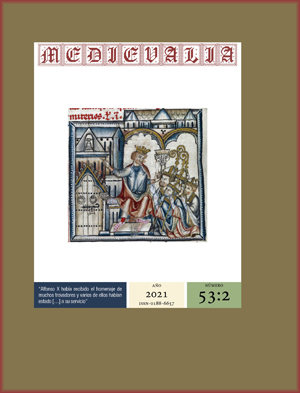Publicado 2022-03-22
Palabras clave
Cómo citar
Derechos de autor 2021 Medievalia

Esta obra está bajo una licencia internacional Creative Commons Atribución-NoComercial 4.0.
Resumen
Although most critical attention on laments for the dead in the Tragicomedia de Calisto y Melibea has focused on Pleberio’s long lament for Melibea in Auto XXI, Elicia’s lament for the loss of her lover, Sempronio, his companion, Pármeno, and her protector, Celestina, is highly significant for plot development. Her lament is a decisive event that sets in motion a plan for revenge that will ultimately lead to the deaths of Calisto and Melibea. This article demonstrates how Elicia’s personal experience of loss brings about significant changes in her characterization. With the help of Areúsa, Elicia hatches a plan for vengeance on the aristocratic lovers that she despises. Building on Louise Haywood’s studies of female laments for the dead, it examines Elicia’s curse on Calisto and Melibea and shows how her words have real and tragic consequences. In Rojas’s world, a prostitute’s expression of grief is a force strong enough to topple the elites of society and fundamentally contribute to the tragedia embedded in his work’s hybrid title.
Descargas
Citas
- Abril-Sánchez, Jorge, “Una familia de meretrices: prostitutas públicas y privadas, cortesanas, rameras y putas viejas en La Celestina”, Celestinesca, vol. 27, 2003, 7-24.
- Berndt, Erna Ruth, Amor, muerte y fortuna en “La Celestina”, Madrid: Gredos, 1963.
- Brooks, Kristen, “Discovering Melibea: Celestina’s Uncontainable doncella encerrada”, Celestinesca, vol. 24, 2000, 95-114.
- Burrus, Victoria A., “Melibea’s Suicide: The Price of Self-Delusion”, Journal of Hispanic Philology, vol. 19, 1994, 57-88.
- Burton, David, “Fallen, Unrepentant, and Unforgiven: Calisto at la Madalena”, Celestinesca, vol. 27, 2003, 35-41.
- Díaz Tena, María Eugenia, “‘Que pareces serena’”, Celestinesca, vol. 36, 2012, 71-102.
- Deyermond, Alan, “¿Cuántas hermanas tenía Celestina? Las funciones de los personajes invisibles”, Celestinesca, vol. 21, no. 1-2, 1997, 15-29.
- Deyermond, Alan, “Female Societies in Celestina”, in Fernando de Rojas and “Celestina”: Approaching the Fifth Century, edited by Ivy A. Corfis and Joseph T. Snow, Madison: Hispanic Seminary of Medieval Studies, 1993, 1-31.
- Deyermond, Alan and Reynaldo Ortiz Galindo, “La inversión perdida de Pleberio: la perspectiva mundana de la Celestina, Acto 21”, Medievalia, vol. 40, 2008, 53-59.
- Fraker, Charles F., “The Importance of Pleberio’s Soliloquy”, Romanische Forschungen, vol. 78, no. 4, 1966, 515-529.
- Guardiola-Griffiths, Cristina, “Calisto y las consecuencias del deseo. Una posible influencia de las Metamorphosis en la Tragicomedia”, Celestinesca, vol. 28, 2004, 33-46.
- Gilman, Stephen, The Art of “Celestina”, Madison: University of Wisconsin Press, 1956.
- Haywood, Louise M., “Models for Mourning and Magic Words in Celestina”, Bulletin of Hispanic Studies, vol. 78, no. 1, 2001, 81-88.
- Haywood, Louise M., “ ‘Sola yo, la mal fadada’: Secular Castilian Female-Voice Laments for the Dead”, in Cultural Contexts/Female Voices, edited by Louise M. Haywood, London: Department of Hispanic Studies, Queen Mary and Westfield College, 2000, 27-40.
- Iglesias, Yolanda, “Rompiendo las cadenas: el libre albedrío en los personajes de La Celestina”, Celestinesca, vol. 34, 2010, 57-73.
- Lida de Malkiel, María Rosa, La originalidad artística de “La Celestina”, Buenos Aires: Editorial Universitaria de Buenos Aires, 1962.
- Martí Caloca, Ivette, “Melibea: eje de la scriptum ligata de La Celestina”, Celestinesca, vol. 36, 2012, 161-178.
- Pattison, David G., “Deaths and Laments in Celestina”, Bulletin of Hispanic Studies, vol. 78, no. 1, 2001, 139-143.
- Rank, Jerry R., “‘O cruel juez, y que mal pago me has dado…’: Or Calisto’s Urban Network”, in Fernando de Rojas and “Celestina”: Approaching the Fifth Century, edited by Ivy A. Corfis and Joseph T. Snow, Madison: Hispanic Seminary of Medieval Studies, 1993, 155-164.
- Russell, Peter E. (ed.), La Celestina. Comedia o tragicomedia de Calisto y Melibea, 2nd ed., Madrid: Clásicos Castalia, 2018.
- Sánchez y Sánchez, Samuel, “Death Gets Personal: Inventing Early Modern Grief in 15th Century Spain”, Celestinesca, vol. 34, 2010, 145-177.
- Scarborough, Connie L., “Speaking of Celestina: Soliloquy and Monologue in the Tragicomedia de Calisto y Melibea”, Celestinesca, vol. 36, 2012, 209-236.
- Scarborough, Connie L., “The Tragic/Comic Calisto: Obsessed and Insecure”, Celestinesca, vol. 34, 2010, 179-200.
- Severin, Dorothy S. (ed.), La Celestina, 30th ed., Madrid: Cátedra, 2020.
- Snow, Joseph T., “Celestina’s Claudina”, Studies in Honor of Alan D. Deyermond: A North American Tribute, edited by John S. Miletich, Madison: Hispanic Seminary of Medieval Studies, 1986, 257-277.
- Snow, Joseph T., “Las tres primas del entorno celestinesco y una nota sobre el tema del linaje”, Celestinesca, vol. 32, 2008, 291-305.
- Wardropper, Bruce W., “Pleberio’s Lament for Melibea and the Medieval Elegiac Tradition”, Modern Language Notes, vol. 79, no. 2, 1964, 140-152.

